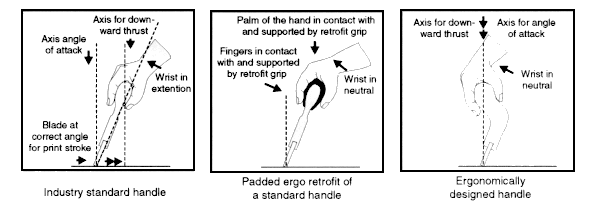Control of Ergonomic Hazards from Squeegee Handles in the Screen-Printing Industry
1997
DHHS (NIOSH) Publication Number 97-137
Hazard
Repetitive use of hand tools (particularly those that compress the palm of the hand and are held with a pinch or precision grip) may result in the development of carpal tunnel syndrome and other musculoskeletal disorders of the hand, wrist, and arm. Workers in the screen-printing industry use wooden-handled squeegees to force ink through a screen and into a substrate. The industry standard handle is approximately 1 inch wide and is grasped in both hands using a pinch grip. The narrowness of the grip requires forceful contractions by muscles in the forearm and wrist. When the user exerts significant downward forces with the handle, the handle places pressure on the mid-palm of the hands, causing possible compression of the median nerve.
Controls
Studies funded by the National Institute for Occupational Safety and Health (NIOSH) indicate that redesign of the squeegee handle can significantly reduce hand pain and fatigue.
Modified Squeegee Handle
- Squeegee handles for manual screen print workers should be designed to conform to the shape of the hand when in a somewhat relaxed and open position (see ILLUSTRATION). The handle surface should make full contact with the fingers and surface of the palm of the hand. The diameter of the grip should be at least 18% wider than the grip diameter of the industry standard handle. Padding the handle with a compressible surface has been shown to reduce hand pain and fatigue significantly when used over time and may result in lower carpal tunnel pressures. Standard squeegee handles can be modified by adding compressible rubber grips. Handles/padding should be provided in varying widths and diameters to accommodate workers with different hand sizes.
Illustration: Squeegee Handle Designs

*NIOSH is the Federal agency responsible for conducting research and making recommendations for preventing work-related illnesses and injuries. All HAZARD CONTROLS are based on research studies that show how worker exposures to hazardous agents or activities can be significantly reduced.
Acknowledgments
The principal contributors to this HAZARD CONTROLS are Katharyn A. Grant and Jerome P. Flesch, NIOSH. Research was performed under NIOSH Grant 1R43 OHO3357-01, Effect of Squeegee Design on Carpal Tunnel Pressure.
This document is in the public domain and may be freely copied or reprinted. NIOSH encourages all readers of this HAZARD CONTROLS to make it available to all interested employers and workers.
Control of Ergonomic Hazards from Squeegee: Handles in the Screen-Printing Industry
